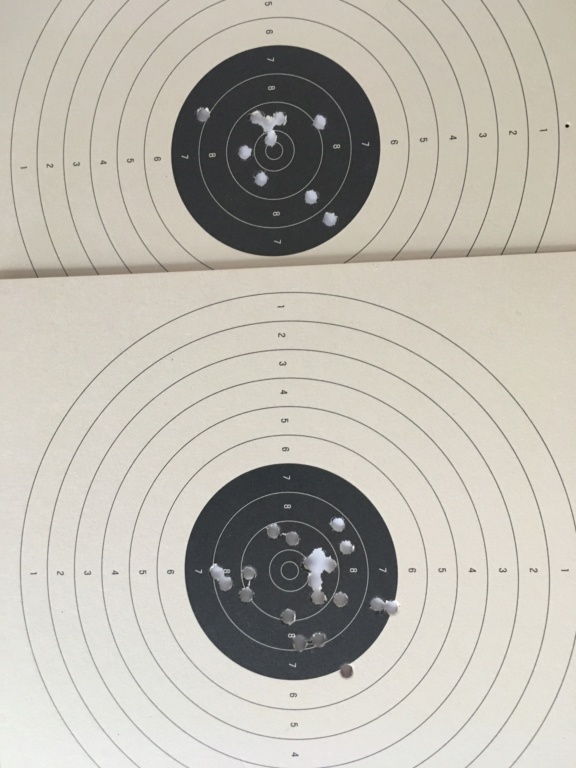Target Analyzing.
+10
CR10X
CrankyThunder
swehrman
john bickar
farmboy
SMBeyer
mikemyers
Wobbley
james r chapman
Mike38
14 posters
Page 1 of 2
Page 1 of 2 • 1, 2 
 Target Analyzing.
Target Analyzing.
I shot a 50 foot 90 round .22 match this morning for training. I don't concern myself with score, just shoot at black targets, no scoring rings. When I packed up and got ready to call it a day, I noticed something on the cardboard backer, see picture attached. There are 3 distinct "groups". 6-7 shots at 1:00. 8-9 shots at 3:00. 9-10 shots closer to the middle at 3:00. Ignore the shots outside the black for now, and yes there are some outside the picture, but I was able to call some of them. What should I do? Move the rear sight 1-2 clicks left and try again next week? Focus on grip placement? Focus on trigger finger placement? Do all three? Your critique is welcome. Thank you.
- Attachments

Mike38- Posts : 514
Join date : 2016-09-15
Age : 65
Location : Illinois
 Re: Target Analyzing.
Re: Target Analyzing.
1" dot? 4" dot? makes a differennce

james r chapman- Admin
- Posts : 6375
Join date : 2012-01-31
Age : 75
Location : HELL, Michigan
 Re: Target Analyzing.
Re: Target Analyzing.
james r chapman wrote:1" dot? 4" dot? makes a difference
Same size black as a 50 foot timed fire target. Approximately 3 inches.

Mike38- Posts : 514
Join date : 2016-09-15
Age : 65
Location : Illinois
 Re: Target Analyzing.
Re: Target Analyzing.
Looks like grip placement issues. I’m struggling with it too.

Wobbley- Admin
- Posts : 4808
Join date : 2015-02-13
 Re: Target Analyzing.
Re: Target Analyzing.
A year or so ago someone here pointed out that my targets had multiple groups. The test was to shoot five rounds, and replace the magazine with a new magazine with five more rounds, WITHOUT disturbing my grip. Back then I was using two hands, but the result of the test really stuck in my mind. If my hands were not in EXACTLY the same spot, neither were the groups.
If I knew then, what I knew now, I'd have shoot 5 rounds at a target, reloaded, and shoot the next 5 rounds at a different target. This seems to be a bonus of one-hand shooting, as if I grip the gun the way Brian Zins suggests, the gun doesn't move in my hand, UNLESS I mess things up while changing magazines.
If I knew then, what I knew now, I'd have shoot 5 rounds at a target, reloaded, and shoot the next 5 rounds at a different target. This seems to be a bonus of one-hand shooting, as if I grip the gun the way Brian Zins suggests, the gun doesn't move in my hand, UNLESS I mess things up while changing magazines.

mikemyers- Posts : 4236
Join date : 2016-07-27
Age : 80
Location : South Florida, and India
 Re: Target Analyzing.
Re: Target Analyzing.
instead of an entire match worth I'd want to see what my tendency was for slow, timed, and rapid individually.
Scott
Scott

SMBeyer- Posts : 375
Join date : 2011-12-07
Age : 52
Location : Southern Illinois
 Re: Target Analyzing.
Re: Target Analyzing.
+1SMBeyer wrote:instead of an entire match worth I'd want to see what my tendency was for slow, timed, and rapid individually.
Scott

farmboy- Posts : 295
Join date : 2012-10-04
Location : Wichita, KS
 Re: Target Analyzing.
Re: Target Analyzing.
I don't see any distinct groups; I see a normal dispersion for a SS.
Work on shooting 10s and Xs. When you start to have targets with very deep 10s and lots of Xs, you are working on a breakthrough.
If you start to have targets with lots of deep 10s and Xs, and a few wide flyers, don't despair. This is part of the progression. You are training yourself to shoot 10s and Xs. Focus on the process that gets you to those shots.
Work on shooting 10s and Xs. When you start to have targets with very deep 10s and lots of Xs, you are working on a breakthrough.
If you start to have targets with lots of deep 10s and Xs, and a few wide flyers, don't despair. This is part of the progression. You are training yourself to shoot 10s and Xs. Focus on the process that gets you to those shots.
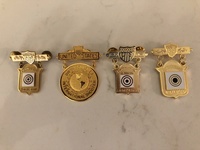
john bickar- Posts : 2280
Join date : 2011-07-09
Age : 100
Location : Menlo Park, CA
chopper likes this post
 Re: Target Analyzing.
Re: Target Analyzing.
I recently had a target when it was a 10 well inside the 10 ring ( ) or it was scattered about the 8 & 7 rings. They were generally low left.. I was seeing those but was having difficulty breaking the shot. What does that indicate?..the 10s it seemed to just stop long enough to release the shot. Something is beginning to click but I’m not there yet.
) or it was scattered about the 8 & 7 rings. They were generally low left.. I was seeing those but was having difficulty breaking the shot. What does that indicate?..the 10s it seemed to just stop long enough to release the shot. Something is beginning to click but I’m not there yet.

Wobbley- Admin
- Posts : 4808
Join date : 2015-02-13
 Re: Target Analyzing.
Re: Target Analyzing.
Wobbley wrote:I recently had a target when it was a 10 well inside the 10 ring () or it was scattered about the 8 & 7 rings. They were generally low left.. I was seeing those but was having difficulty breaking the shot. What does that indicate?..the 10s it seemed to just stop long enough to release the shot. Something is beginning to click but I’m not there yet.
Was this shot in timed fire, rapid fire, slow fire?
I'm a right handed shooter. When I have shots low and left it's typically in rapid fire and I'm jerking the trigger.
-- Scott
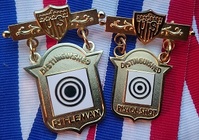
swehrman- Posts : 27
Join date : 2013-05-22
Location : NW Montana
 Re: Target Analyzing.
Re: Target Analyzing.
I would say that that is a normal distribution that is centered a bit to the right and a littleler bit up. I would adjust my red dot to the left three clicks and two clicks down.
I would continue to monitor the shot pattern until I was confidant it was centered.
I would continue to monitor the shot pattern until I was confidant it was centered.
 Re: Target Analyzing.
Re: Target Analyzing.
I would say that that is a normal distribution that is centered a bit to the right and a littleler bit up. I would adjust my red dot to the left three clicks and two clicks down.
I would continue to monitor the shot pattern until I was confidant it was centered.
I would continue to monitor the shot pattern until I was confidant it was centered.
 Re: Target Analyzing.
Re: Target Analyzing.
Slow fire on the 50ft target.swehrman wrote:Wobbley wrote:I recently had a target when it was a 10 well inside the 10 ring () or it was scattered about the 8 & 7 rings. They were generally low left.. I was seeing those but was having difficulty breaking the shot. What does that indicate?..the 10s it seemed to just stop long enough to release the shot. Something is beginning to click but I’m not there yet.
Was this shot in timed fire, rapid fire, slow fire?
I'm a right handed shooter. When I have shots low and left it's typically in rapid fire and I'm jerking the trigger.
-- Scott

Wobbley- Admin
- Posts : 4808
Join date : 2015-02-13
 Re: Target Analyzing.
Re: Target Analyzing.
Wobbley wrote:
Slow fire on the 50ft target.
You wrote that you were having difficulty breaking the shot. Since it's slow fire, my thought is lower the pistol, take a couple of deep breaths, clear your mind, and restart your shot process. That's what I do when I find myself concentrating on the trigger and not on the sights (or dot).
-- Scott

swehrman- Posts : 27
Join date : 2013-05-22
Location : NW Montana
 Re: Target Analyzing.
Re: Target Analyzing.
Since there was no mention of how many or which shots were on call here's my take on this discussion. (Again)
I'd suggest we start analyzing the shot rather than the target
What are we going to learn looking at some big group of shots as a reference to performance? Without some reference to where the shots or string was called when fired, analyzing a target is at best simply a reference for sight adjustments and that's about it. If you called the shots outside the black exactly where they landed, then even sight adjustment isn't needed.
So the real question is, what did we see for the shot / string each time as the sear tripped? Dot approaching center, moving away, unusual dip or rise that is not part off the normal pattern, etc., etc.
A real deadly thing to "see" is the dot actually seem to stop moving (this generally means we may not be "seeing" but "remembering" or we reached a static point of forces and have interrupted the trigger process). If we are not careful, this can produce a slight or even major "flinch or tremor" when the additional trigger pressure is applied and create those shots that are off the call because we are so focused on the visual picture of that static dot, we miss the movement that is actually happening because of the finite amount of time it takes to see and process new visual information plus the mind wanting to see that dot in the center.
It takes some training to see the process rather than some static "sight picture" that we believe is the perfection we are looking for. Learn to see the dot / sight process (wobble) on the target and get the trigger operating as the dot / sights are approaching the center of the wobble area (if it gets there and stops, you are now behind the curve). Call the shot when it goes off based on the sight picture you see as the dot / sights start to rise off the target.
If the shots are on call, then grip, sights, etc. are when they need to be and its just the timing and trigger process you need work on. If its not on call, then we have to work on seeing the shot and calling it first before we can figure out what else is happening.
Its hard to get the proper feedback loop started (improving our shot / trigger process) until we can see what is happening so we can work on what we want to learn to make happen.
So if we are seeing different groups on the target, are we seeing different groups on the call? If yes, then simply reference the groups to what the sight picture "movie" or movement as the shot was fired and where we were at in the wobble process when the sear actually tripped and gun started to rise. I'll bet that some of the shots actually fired as the wobble was moving slight up, left and down right in its pattern after passing through the center of the wobble. The goal is to complete the trigger as the wobble is approaching its smallest area. So we need to learn our wobble and see the process, not just look for some static picture of perfection.
CR
I'd suggest we start analyzing the shot rather than the target
What are we going to learn looking at some big group of shots as a reference to performance? Without some reference to where the shots or string was called when fired, analyzing a target is at best simply a reference for sight adjustments and that's about it. If you called the shots outside the black exactly where they landed, then even sight adjustment isn't needed.
So the real question is, what did we see for the shot / string each time as the sear tripped? Dot approaching center, moving away, unusual dip or rise that is not part off the normal pattern, etc., etc.
A real deadly thing to "see" is the dot actually seem to stop moving (this generally means we may not be "seeing" but "remembering" or we reached a static point of forces and have interrupted the trigger process). If we are not careful, this can produce a slight or even major "flinch or tremor" when the additional trigger pressure is applied and create those shots that are off the call because we are so focused on the visual picture of that static dot, we miss the movement that is actually happening because of the finite amount of time it takes to see and process new visual information plus the mind wanting to see that dot in the center.
It takes some training to see the process rather than some static "sight picture" that we believe is the perfection we are looking for. Learn to see the dot / sight process (wobble) on the target and get the trigger operating as the dot / sights are approaching the center of the wobble area (if it gets there and stops, you are now behind the curve). Call the shot when it goes off based on the sight picture you see as the dot / sights start to rise off the target.
If the shots are on call, then grip, sights, etc. are when they need to be and its just the timing and trigger process you need work on. If its not on call, then we have to work on seeing the shot and calling it first before we can figure out what else is happening.
Its hard to get the proper feedback loop started (improving our shot / trigger process) until we can see what is happening so we can work on what we want to learn to make happen.
So if we are seeing different groups on the target, are we seeing different groups on the call? If yes, then simply reference the groups to what the sight picture "movie" or movement as the shot was fired and where we were at in the wobble process when the sear actually tripped and gun started to rise. I'll bet that some of the shots actually fired as the wobble was moving slight up, left and down right in its pattern after passing through the center of the wobble. The goal is to complete the trigger as the wobble is approaching its smallest area. So we need to learn our wobble and see the process, not just look for some static picture of perfection.
CR
Last edited by CR10X on Mon Feb 11, 2019 4:53 pm; edited 1 time in total
CR10X- Posts : 1777
Join date : 2011-06-17
Location : NC
 Re: Target Analyzing.
Re: Target Analyzing.
JHere is a target shot recently. There’s a nice cluster in the ten ring and I bet a lot would be Xes if this had an x-ring. There are 6 shots or so in the 7&8 ring at 8, o’clock that would be nicer if I had them centered on the ten ring. The problem was I saw the dot there and I still took the shot anyway. It wasn’t a jerk or poor trigger control. I shot them there almost on purpose. On these shots the “null” or “dwell” never came in the center. If it had been all at one time or in one 10 shot string I’d rebuild the grip and stance..,but they’re at random.. the others were random in the string. Most I saw but I can accept those...it’s the cluster at 8...frustrating.
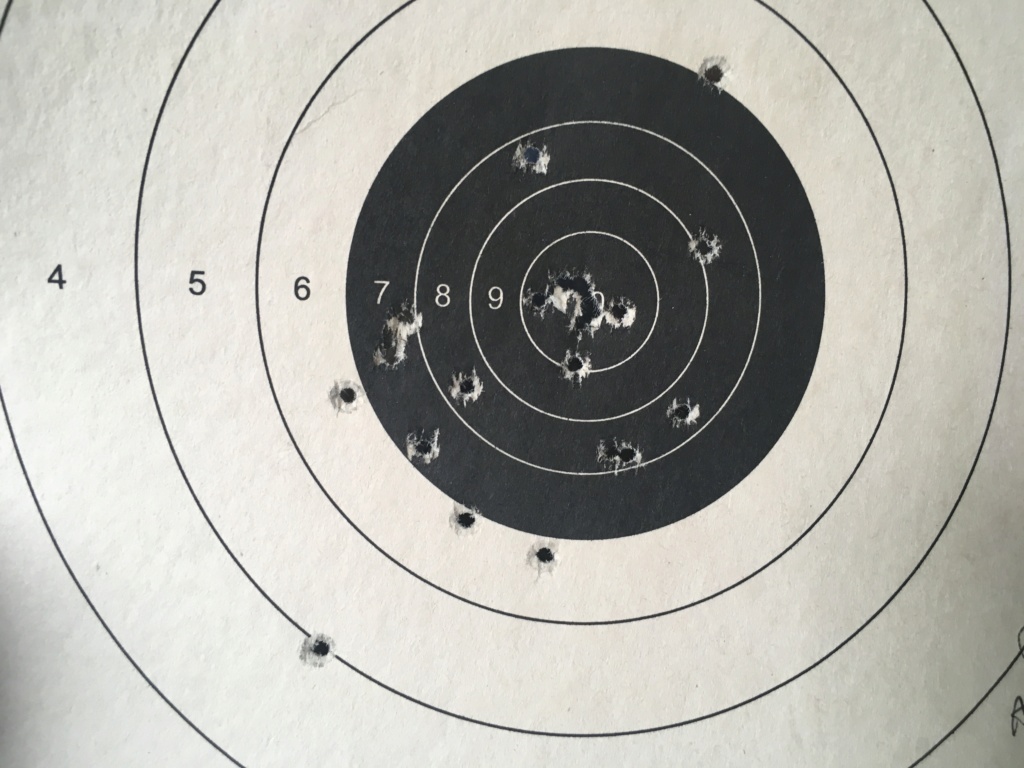


Wobbley- Admin
- Posts : 4808
Join date : 2015-02-13
 Re: Target Analyzing.
Re: Target Analyzing.
The problem was I saw the dot there and I still took the shot anyway. It wasn’t a jerk or poor trigger control. I shot them there almost on purpose. On these shots the “null” or “dwell” never came in the center.
Yep, recognizing the shots that are not coming together / recognizing those that are is the crux of learning to shoot a large percentage of 10s.
One issue is "seeing it there". If its there and we seem to see the dot immobile or stopped; sometimes the time has passed or we may not notice that its not "there" anymore by the time the trigger process is complete. That is not (for me) what to look for. "Seeing it moving consistently towards the center of my recognized minimum wobble centered in the black" is what I'm looking for.
If "seeing it there" simply means "on call in the area of my minimum wobble" then I think you are on track!
Secondly, "I still took the shot anyway." was / is one of the hardest thing for me to deal with too!
That's one reason we really need to see the pattern and understand what is consistent for the best shot. Learning what looks good and what doesn't look like it should and automatically doing what we should in each case is about the most difficult part (at least for me). It's just that we've gotten our time and commitment all wrapped up the shot that we are working on and we don't want to abandon all that effort.
That's another reason I stress calling and scoping the shots when training. We need to reinforce the process, timing, etc. for those deep tens and learn to recognize the pattern and timing that produced those shots. Simply firing a bunch of shots and then checking may not be the best process for seeing, understanding and remembering that wobble pattern and timing that produced the deep 10 shot. Yes, we can call the shots out without scoping, but the benefit of taking the time to call, scope, see and remember what we saw for that 10 that we just shot is missing. And I needed that time to reinforce what I want to do.
And, if we have a shot that's out, probably because we did not restart (I will refrain from saying abort, since it tends to sound negative) even though we knew we should; its better to take the time to re-scope on a deep 10 and replay that shot in our mind before taking the next shot. Remember what we saw for the good shot, and then replay it in real time on the next shot.
Very good group by the way, looks like a B-16 and they are tough to shoot on for me!
CR
Last edited by CR10X on Mon Feb 11, 2019 5:05 pm; edited 1 time in total
CR10X- Posts : 1777
Join date : 2011-06-17
Location : NC
 Re: Target Analyzing.
Re: Target Analyzing.
Thanks, it’s the 50 foot B2 shot indoors...
My analysis was to “Only take good shots”. We’ll see if I can
My analysis was to “Only take good shots”. We’ll see if I can

Wobbley- Admin
- Posts : 4808
Join date : 2015-02-13
 Re: Target Analyzing.
Re: Target Analyzing.
Now we're getting somewhere!CR10X wrote:That's one reason we really need to see the pattern and understand what is consistent for the best shot. Learning what looks good and what doesn't look like it should and automatically doing what we should in each case is about the most difficult part (at least for me). It's just that we've gotten our time and commitment all wrapped up the shot that we are working on and we don't want to abandon all that effort.
I had an absolutely miserable range session yesterday and it seemed that the majority of the shots broke on the perimeter of the wobble...
I was shooting a donut around the center of the target.
Previously the majority seemed to have been braking at the nucleus of the wobble. It was really weird, as though the dot would automatically zip to the center as the shot broke!
My polarity seemed to have reversed for the day!
I was able to call every shot though, just to add to the frustration...(and scoped each one to verify)
Thanks!

DA/SA- Posts : 1513
Join date : 2017-10-09
Age : 68
Location : Southeast Florida
 Re: Target Analyzing.
Re: Target Analyzing.
This is a very good subject....
I don't now if I have a pattern to my wobble. I see a squiggly line in the black but never paid much attention to see if there was a pattern to it. A friend of mine who is a better shooter than me was taught to make a figure 8. I am just remembering this now. Would this be something to do?
I have plateaued for a while now so something like this will help me break thought.
I don't now if I have a pattern to my wobble. I see a squiggly line in the black but never paid much attention to see if there was a pattern to it. A friend of mine who is a better shooter than me was taught to make a figure 8. I am just remembering this now. Would this be something to do?
I have plateaued for a while now so something like this will help me break thought.
285wannab- Posts : 321
Join date : 2014-08-13
 Re: Target Analyzing.
Re: Target Analyzing.
Wobbley wrote:Thanks, it’s the 50 foot B2 shot indoors...
My analysis was to “Only take good shots”. We’ll see if I can
I think there is a huge misconception to what training actually means. I think it is what keeps shooters from progressing and growing. Shooting/training isn’t just about shooting great scores and great groups. It’s a complete process, but nobody seems to be breaking it down into the individual fundamental and perfects each one. What happens is we try and combine them all at the same time and we end up with poor/marginal results.
I keep hearing that I did this or that........
Learn each fundamental. Dry train it and then live train. That’s right the individual fundamental. Then train the next one. And the next. So when you train it is acceptable and good to have shots that are not a 10 or in the white as long as it is part of the training process. Then when you shoot for group/record focus on the shot plan and let the subconscious mind do what you trained it to do!
If you really train instead of shoot and think your training you will see growth. Training is planned and followed. You make analysis along the way. Then you keep what’s good and change what’s bad. Unfortunately most just think they’re training.......you need to know your training.
So “only taking good shots” can inhibit the process. Learning what is acceptable vs. what is perfect can foul things up. Example; area aiming. Getting too concerned over the wobble inhibits trigger squeeze. Accepting the wobble and squeezing through will get you 10’s. Hold has less detriment than or trigger squeeze. So if you don’t train it, you’ll never know.
Jon
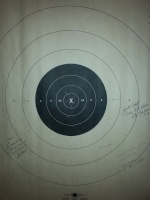
Jon Eulette- Posts : 4399
Join date : 2013-04-15
Location : Southern Kalifornia
chopper likes this post
 Re: Target Analyzing.
Re: Target Analyzing.
Disclaimer: These are my thoughts and ideas and opinions on shooting. Others may have differing opinions or solutions. To each his own. No offense meant, none taken for differing opinions.
(1) Shooting doughnuts is usually a matter of working on a better trigger process and timing. And it's frustrating. This is one condition where a trial of focusing on the target might produce some changes. Complete the trigger while moving towards the center, not when it gets there. Don't chase the dot with the trigger outside of the minimum wobble area.
(2) I would not suggest the concept of "make a pattern" but "learn your pattern" so you know and can see when the wobble is consistent and centered around an area on the target. You can adjust your stance (or grips) to get the center of the pattern over the center of the target. Some people say Natural Point of Aim. I'd rather say the most consistent position for best wobble in my Area of Aim.
(3) I would not really say "take the good shots", but learn what a good shot looks like and let yourself complete it.
As Jon said, break it down into parts, train on the parts, assess the progress and find the next part to work on. Sometimes you just need to sit in a chair with an empty gun and learn what your trigger feels like without any distractions like sight alignment, sight picture, or wobble area. Just dryfire and feel the trigger pressure and grip pressure...... Every little part helps.
CR
(1) Shooting doughnuts is usually a matter of working on a better trigger process and timing. And it's frustrating. This is one condition where a trial of focusing on the target might produce some changes. Complete the trigger while moving towards the center, not when it gets there. Don't chase the dot with the trigger outside of the minimum wobble area.
(2) I would not suggest the concept of "make a pattern" but "learn your pattern" so you know and can see when the wobble is consistent and centered around an area on the target. You can adjust your stance (or grips) to get the center of the pattern over the center of the target. Some people say Natural Point of Aim. I'd rather say the most consistent position for best wobble in my Area of Aim.
(3) I would not really say "take the good shots", but learn what a good shot looks like and let yourself complete it.
As Jon said, break it down into parts, train on the parts, assess the progress and find the next part to work on. Sometimes you just need to sit in a chair with an empty gun and learn what your trigger feels like without any distractions like sight alignment, sight picture, or wobble area. Just dryfire and feel the trigger pressure and grip pressure...... Every little part helps.
CR
CR10X- Posts : 1777
Join date : 2011-06-17
Location : NC
 Re: Target Analyzing.
Re: Target Analyzing.
Thanks Ed and Jon. I guess I have become lazy with my shooting and after reading these posts it helps me to realize that. I am at a number now and just figured that's about as good as I will be. It's good to read new things/ideas to help move forward.
285wannab- Posts : 321
Join date : 2014-08-13
 Area Aiming
Area Aiming
DA/SA wrote:.......I had an absolutely miserable range session yesterday and it seemed that the majority of the shots broke on the perimeter of the wobble.........I was shooting a donut around the center of the target.
I had a long discussion with Dave Salyer about this, after reading an article he wrote long ago and posting it here:
https://www.bullseyeforum.net/t8516-area-aiming-by-dave-salyer?highlight=salyer
According to Dave, if you aim for a specific point on the target, you will probably get a circle of holes surrounding that point, with none actually hitting it.
Reasons are that #1, you can not shoot better than your wobble area, until you learn how to reduce the wobble area. Also, that what you see is "history". It's where the red dot WAS, but won't be by the time you actually fire.
Statistically, if you follow Dave's advice, you'll get a grouping of holes, with the majority of them positioned close to the center of the group - which is what statistics says will happen. It's like a "bell curve" distribution, with most holes at the center, and fewer and fewer holes as you move away from the center.
.........and if you guys think like me, my first thought was "hogwash, how can you hit something without aiming at it?".
If you think it through though, it makes sense.
And if you can forget how silly it sounds, and actually try it, it works.
If someone had super-human strength, and really could "freeze" the dot in place, they would get the same result, so it's a win/win situation.

mikemyers- Posts : 4236
Join date : 2016-07-27
Age : 80
Location : South Florida, and India
Page 1 of 2 • 1, 2 
 Similar topics
Similar topics» Browning Buck Mark Field Target vs. Ruger Mk IV Target?
» 6" Pardini + 1st RF Target + Target w/Horton grips
» What class would I shoot in?
» Best target ever
» New (for me) target .22
» 6" Pardini + 1st RF Target + Target w/Horton grips
» What class would I shoot in?
» Best target ever
» New (for me) target .22
Page 1 of 2
Permissions in this forum:
You cannot reply to topics in this forum

